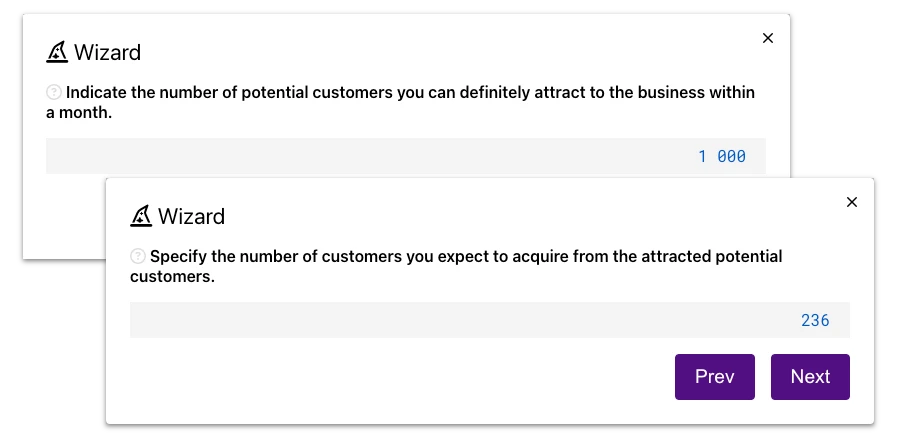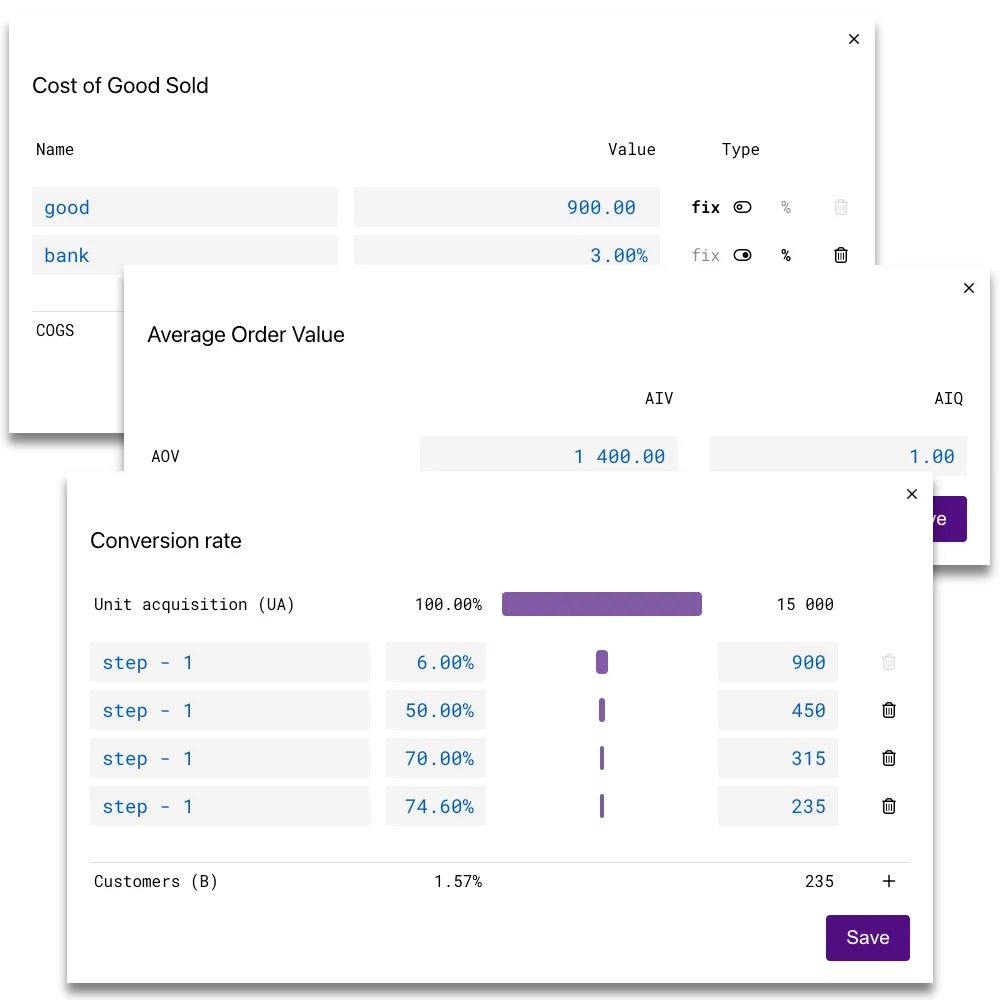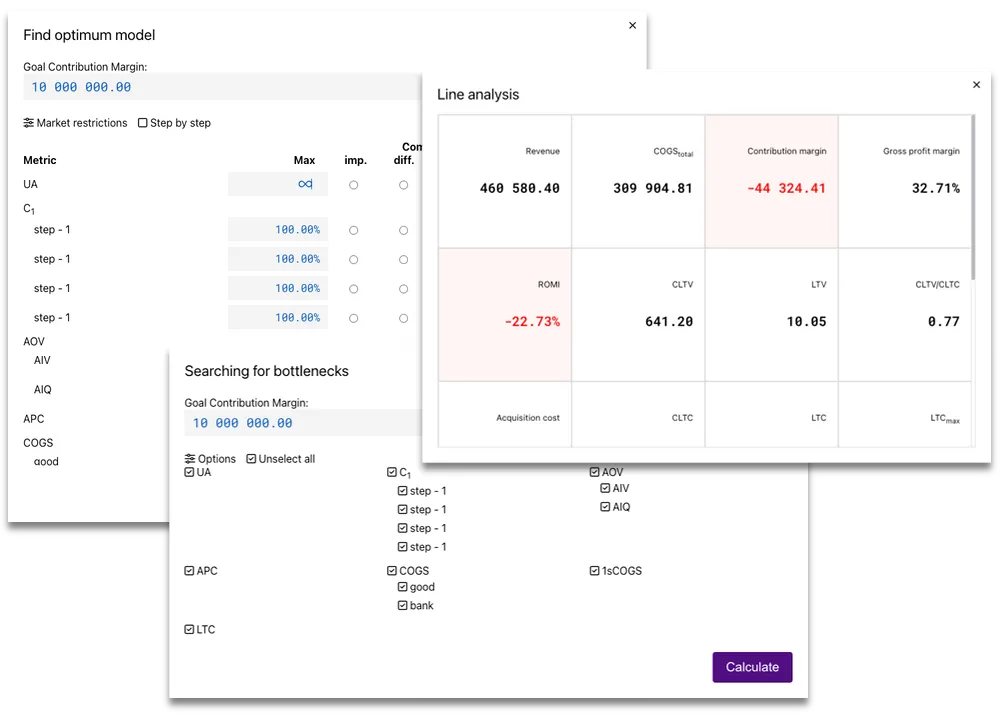Unit economics enables you to identify business processes where even minimal improvements can lead to significant growth for your business.
- Assistant. The assistant will ask you a few simple questions about your idea, such as how many potential customers you can attract per month, what budget you’re willing to spend on customer acquisition, and so on. After that, it will automatically fill in the unit economics template and find the optimal configuration of your business parameters that will help you reach your goals.

- Sales Funnel. Every business has its own sales funnel, with customers following a unique journey. To reflect this in your unit economics, construct your sales funnel accordingly.
- Average Order Value. The average order value varies depending on the business model. Simply specify the structure of the transaction — whether it's transactional, commerce, or subscription-based.
- Cost of Goods Sold. Consider all the costs involved in your business, as this will enable better control over business processes.
- Formulas. You don't need to worry about formulas—just input your data. ueCalc will automatically interpret and incorporate your entries into the calculations, allowing you to focus solely on your data while ueCalc handles the rest.

- Optimal Configuration. ueCalc employs Goldratt's Theory of Constraints to determine the optimal configuration of metrics required to achieve the target Contribution Margin. It considers the constraints present in the business process improvement model to tailor the configuration effectively.
- Growth Points. ueCalc identifies business processes that can drive significant growth to help you achieve your target. Simply set your goal, and analyze which processes will most effectively lead you to it.
- Summary. Analyzing unit economics by 20 parameters such as CLTV/CAC ratio, gross profitability, first deal margin and more, a simple way to quickly understand the state of unit economics in a business.


Unit Economics is a straightforward tool that enables you to quickly assess your business's current state. It helps identify which business processes require immediate attention and which improvements will yield the best results.
Calculate your unit economics!
Daniil Khanin, CEO ueCalc
For which business models can unit economics be calculated? Unit economics can be calculated for virtually any business model. Currently, ueCalc offers templates for transactional, e-commerce, and SaaS business models. These templates make it straightforward to calculate the unit economics for most products. If your business employs multiple monetization strategies, you should calculate unit economics separately for each type.What to do if ueCalc does not find the optimal configuration? This situation can occur when the current system constraints make it impossible to reach the target value. Try adjusting the constraint settings; for SaaS models, consider fixing the share of clients using each tariff plan and attempt to find a new configuration. If these adjustments do not resolve the issue, it may be necessary to reconsider your entire business model.What costs are COGS? In unit economics, Cost of Goods Sold (COGS) refers to variable costs that are directly incurred during a transaction with a customer. This does not include marketing costs associated with acquiring customers or fixed costs such as development expenses, server costs, or employee salaries.What is APC? In unit economics, Average Purchase Count (APC) represents the average number of transactions a customer makes over their lifetime. This metric reflects both customer retention and the duration of their engagement with the product. For SaaS businesses, APC indicates the average number of months customers remain subscribed, while for e-commerce businesses, it represents the number of purchases a customer makes.What is the difference between CLTV and LTV? Both CLTV (Customer Lifetime Value) and LTV (Lifetime Value) are metrics that reflect gross profit, but they are used in different contexts: CLTV (Customer Lifetime Value) represents the total gross profit generated from all transactions with a single customer over their entire relationship with the company; LTV (Lifetime Value) often refers to the gross profit per potential customer, or the value a customer could potentially bring if they convert and engage with the product. The distinction is particularly relevant when scaling a business. As you increase the influx of potential customers, you should compare the gross profit per potential customer (LTV) with the marketing costs to attract those customers. This comparison helps in assessing the efficiency of your marketing spend relative to the value each potential customer brings.
ueCalc
Made with love for the whole world
We believe that anyone can attempt to start their own business, and we are here to assist them.
- Products
- Calconomics
- Company
- © 2025 Khanin Solutions S.L.
Barcelona, Spain